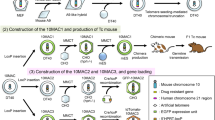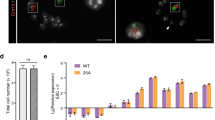Abstract
Human chromosomes or chromosome fragments derived from normal fibroblasts were introduced into mouse embryonic stem (ES) cells via microcell-mediated chromosome transfer (MMCT) and viable chimaeric mice were produced from them. Transferred chromosomes were stably retained, and human genes, including immunoglobulin (Ig) κ, heavy, λ genes, were expressed in proper tissue-specific manner in adult chimaeric tissues. In the case of a human chromosome (hChr.) 2-derived fragment, it was found to be transmitted to the offspring through the germline. Our study demonstrates that MMCT allows for introduction of very large amounts of foreign genetic material into mice. This novel procedure will facilitate the functional analyses of human genomes in vivo.
This is a preview of subscription content, access via your institution
Access options
Subscribe to this journal
Receive 12 print issues and online access
$209.00 per year
only $17.42 per issue
Buy this article
- Purchase on Springer Link
- Instant access to full article PDF
Prices may be subject to local taxes which are calculated during checkout
Similar content being viewed by others
References
Mansour, S.L., Thomas, K.R. & Capecchi, M.R. Disruption of the proto-oncogene int-2 in mouse embryo-derived stem cells: a general strategy for targeting mutations to non-selectable genes. Nature 336, 348–352 (1988).
Jakobovits, A. et al. Germ-line transmission and expression of a human-derived yeast artificial chromosome. Nature 362, 255–258 (1993).
Strauss, W.M. et al. Germ line transmission of a yeast artificial chromosome spanning the murine alpha 1(1) collagen locus. Science 259, 1904–1907 (1993).
Ramirez-Solis, R., Liu, P. & Bradley, A. Chromosome engineering in mice. Nature 378, 720–724 (1995).
Smith, A.J.H. et al. A site-directed chromosomal translocation induced in embryonic stem cells by Cre-loxP recombination. Nature Genet. 9, 376–385 (1995).
Hooper, M.L. Isolation of genetic variants and fusion hybrids from embryonal carcinoma cell lines. in Teratocardnomas and Embryonic Stem Cells: a Practical Approach (ed. Robertson, E.J.) 51–70 (IRL press, Oxford, 1987).
Benham, F.J., Quintero, M.A. & Goodfellow, P.N. Human-mouse hybrids with an embryonal carcinoma phenotype continue to transcribe HLA-A, B, C. EMBO J. 2, 1963–1968 (1983).
Illmensee, K., Hoppe, P.C. & Croce, C.M. Chimeric mice derived from human-mouse hybrid cells. Proc. Natl. Acad. Sci. USA 75, 1914–1918 (1978).
Illmensee, K. & Croce, C.M. Xenogenetic gene expression in chimeric mice derived from rat-mouse hybrid cells. Proc. Natl. Acad. Sci. USA 76, 879–883 (1979).
Fournier, R.E. & Ruddle, F.H. Microcell-mediated transfer of murine chromosomes into mouse, Chinese hamster, and human somatic cells. Proc. Natl. Acad. Sci. USA 74, 319–323 (1977).
Katoh, K., Takahashi, Y., Hayashi, S. & Kondoh, H. Improved mammalian vectors for high expression of G418 resistance. Cell Struct. Fund. 12, 575–580 (1987).
Honjo, T. & Alt, F.W. (eds.) Immunoglobulin Genes. Second edition. (Academic Press, London, 1995).
Lengauer, C., Green, E.D. & Cremer, T. Fluorescence in situ hybridization of YAC clones after Alu-PCR amplification. Genomics 13, 826–8 (1992).
Dorin, J.R. et al. Gene targeting for somatic cell manipulation: rapid analysis of reduced chromosome hybrids by Alu-PCR fingerprinting and chromosome painting. Hum. Mol. Genet. 1, 53–59 (1992).
Yagi, T. et al. A novel ES cell line, TT2, with high germline-differentiating potency. Anal. Biochem. 214, 70–76 (1993).
Uchida, M., Tokunaga, T., Aizawa, S., Niwa, K. & Imai, H. Isolation and nature of mouse embryonic stem cell line efficiently producing female germ-line chimeras. Anim. Sci. Technol.(Jpn.) 66, 361–367 (1995).
Koi, M. et al. Tumor cell growth arrest caused by subchromosomal transferable DNA fragments from chromosome 11. Science 260, 361–364 (1993).
Jonsson, J.J., Williams, S.R. & Mclvor, R.S. Sequence and functional characterization of the human purine nucleoside phosphorylase promoter. Nucl. Acids Res. 19, 5015–5020 (1991).
Tomatsu, S. et al. The organization and the complete nucleotide sequence of the human NADH-cytochrome b5 reductase gene. Gene 80, 353–361 (1989).
Yamauchi-Takihara, K., Sole, M.J., Liew, J., Ing, D. & Liew, C.C. Characterization of human cardiac myosin heavy chain genes. Proc. Natl. Acad. Sci. USA 86, 3504–3508 (1989).
Berchtold, M.W. & Means, A.R. The Ca2+-binding protein pan/albumin: molecular cloning and developmental regulation of mRNA abundance. Proc. Natl. Acad. Sci. USA 82, 1414–1418 (1985).
Devlin, B.H., Wefald, F.C., Kraus, W.E., Bernard, T.S. & Williams, R.S. Identification of a muscle-specific enhancer within the 5′-flanking region of the human myoglobin gene. J. Biol. Chem. 264, 13896–13901 (1989).
Lowe, J.B. et al. Human liver fatty acid binding protein. J. Biol. Chem. 260, 3413–3417 (1985).
Trask, R.V. & Billadello, J.J. Tissue-specific distribution and developmental regulation of M and B creatine kinase mRNAs. Biochim. Biophys. Acta 1049, 182–188 (1990).
Hatakeyama, M. et al. Interleukin-2 receptor β chain gene: generation of three receptor forms by cloned human α and β chain cDNAs. Science 244, 551–556 (1989).
Griffiths, A.D. et al. Isolation of high affinity human antibodies directly from large synthetic repertoires. EMBO J. 13, 3245–3260 (1994).
Green, L.L. et al. Antigen-specific human monoclonal antibodies from mice engineered with human Ig heavy and light chain YACs. Nature Genet. 7, 13–21 (1994).
Mendez, M.J. et al. Functional transplant of megabase human immunoglobulin loci recapitulates human antibody responses in mice. Nature Genet. 15, 146–157 (1997).
Gropp, A., Winking, H., Herbst, E.W. & Claussen, C.P. Murine trisomy: Developmental profiles of the embryo, and isolation of trisomic cellular systems. J. Exp. Zool. 228, 253–269 (1983).
Epsteiri, C.J. et al. Production of viable adult trisomy 17 reversible diploid mouse chimeras. Proc. Natl. Acad. Sci. USA 79, 4376–4380 (1982).
Dewey, M.J., Martin, D.W., Martin, G.R. & Mintz, B. Mosaic mice with teratocarcinoma-derived mutant cells deficient in hypoxanthine phosphoribosyltransferase. Proc. Natl. Acad. Sci. USA 74, 5564–5568 (1977).
Lonberg, N. et al. Antigen-specific human antibodies from mice comprising four distinct genetic modifications. Nature 368, 856–859 (1994).
Wagner, S.D. et al. The diversity of antigen-specific monoclonal antibodies from transgenic mice bearing human immunoglobulin gene miniloci. Eur. J. Immunol. 24, 2672–2681 (1994).
Cook, G.P. et al. A map of the human immunoglobulin VH locus completed by analysis of the telomeric region of chromosome 14q. Nature Genet. 7, 162–168 (1994).
Hunt, P., LeMaire, R., Embury, P., LeMaire, R., & Mroz, K. Analysis of chromosome behavior in intact mammalian oocytes: monitoring the segregation of a univalent chromosome during female meiosis. Hum. Mol. Genet. 4, 2007–2012 (1995).
Brown, W., Heller, R., Loupart, M.-L., Shen, M.-H. & Chand, A. Mammalian artificial chromosomes. Curr. Opin. Genet. Dev. 6, 281–288 (1996).
Pritchard, C. & Goodfellow, P.N. Development of new methods in human gene mapping: selection for fragments of the human Y chromosome after chromosome mediated gene transfer. EMBO J. 5, 979–985 (1986).
Farr, C.J. et al. Generation of a human X-derived minichromosome using telomere-associated chromosome fragmentation. EMBO J. 14, 5444–5454 (1995).
Heller, R., Brown, K.E., Burgtorf, C. & Brown, W.R.A. Mini-chromosome derived from the human Y chromosome by telomere directed chromosome breakage. Proc. Natl. Acad. Sci. USA 93, 7125–7130 (1996).
Dieken, E.S., Epner, E.M., Fiering, S., Fournier, R.E. & Groudine, M. Efficient modification of human chromosomal alleles using recombination-proficient chicken/human microcell hybrids. Nature Genet. 12, 174–182 (1996).
Koi, M., Shimizu, M., Morita, H., Yamada, H. & Oshimura, M. Construction of mouse A9 clones containing a single human chromosome tagged with neomycin-resistance gene via microcell fusion. Jpn. J. Cancer Res. 80, 413–418 (1989).
Klein, R., Jaenichen, R. & Zachau, H.G. Expressed human immunoglobulin K genes and their hypermutation. Eur. J. Immunol. 23, 3248–3271 (1993).
Hattori, M., Hidaka, S. & Sakaki, Y. Sequence analysis of a Kpn I family member near the 3′ end of human beta-globin gene. Nud. Adds Res. 13, 7813–7827 (1985).
Siminovitch, K.A., Bakhshi, A., Goldman, P. & Korsmeyer, S.J. A uniform deleting element mediates the loss of κ genes in human B cells. Nature 316, 260–262 (1985).
Ausubel, F.M. et al. Current Protocols in Molecular Biology. (John Wiley & Sons, Inc., New York, 1994).
Dracopoli, N.C. et al. Current Protocols in Human Genetics. (John Wiley & Sons, Jnc., New York, 1994).
Hanaoka, K., Kato, Y. & Noguchi, T. Comparative study of various teratocarcinomas with different origins on the ability to form chimeric mouse embryos. Dev. Growth Differ. 28, 223–231 (1986).
Hedrick, S.M., Cohen, D.I., Nielsen, E.A. & Davis, M.M. Isolation of cDNA clones encoding T cell-specific membrane-associated proteins. Nature 308, 149–153 (1984).
Marks, J.D., Tristem, M., Karpas, A. & Winter, G. Oligonucleotide primers for polymerase chain reaction amplification of human immunoglobulin variable genes and design of family-specific oligonucleotide probes. Eur. J. Immunol. 21, 985–991 (1991).
Williams, S.C. & Winter, G. Cloning and sequencing of human immunoglobulin VA, gene segments. Eur. J. Immunol. 23, 1456–1461 (1993).
Watanabe, S. et al. Stable production of mutant mice from double gene converted ES cells with puromycin and neomycin. Biochem. Biophys. Res. Commun. 213, 130–137 (1995).
Author information
Authors and Affiliations
Corresponding author
Rights and permissions
About this article
Cite this article
Tomizuka, K., Yoshida, H., Uejima, H. et al. Functional expression and germline atransmission of a human chromosome fragment in chimaeric mice. Nat Genet 16, 133–143 (1997). https://doi.org/10.1038/ng0697-133
Received:
Accepted:
Issue Date:
DOI: https://doi.org/10.1038/ng0697-133
This article is cited by
-
Full-length human dystrophin on human artificial chromosome compensates for mouse dystrophin deficiency in a Duchenne muscular dystrophy mouse model
Scientific Reports (2023)
-
Characterization of human anti-EpCAM antibodies for developing an antibody–drug conjugate
Scientific Reports (2023)
-
Actively transcribed rDNA and distal junction (DJ) sequence are involved in association of NORs with nucleoli
Cellular and Molecular Life Sciences (2023)
-
Nannochloropsis artificial chromosomes (NannoACs) loom on the horizon
Journal of Oceanology and Limnology (2023)
-
Efficient human-like antibody repertoire and hybridoma production in trans-chromosomic mice carrying megabase-sized human immunoglobulin loci
Nature Communications (2022)



